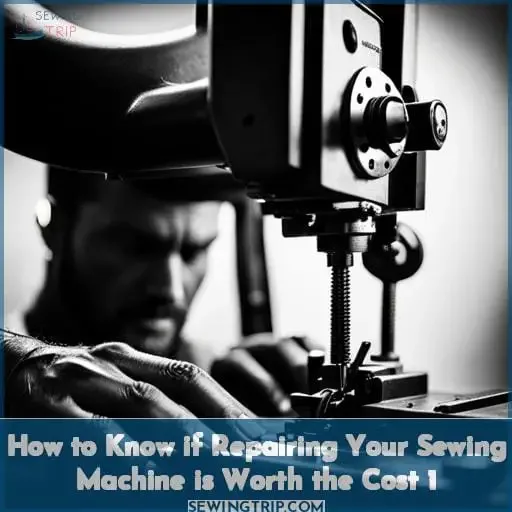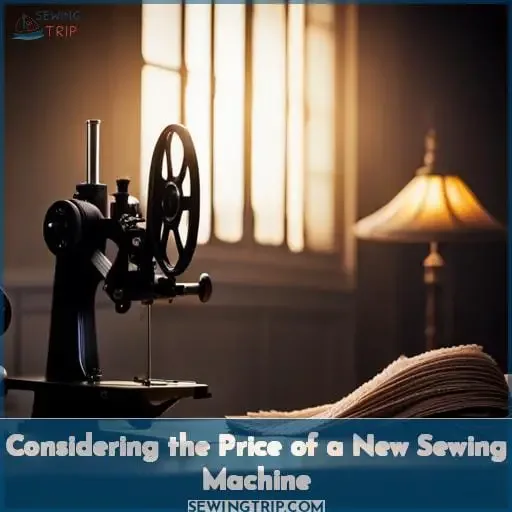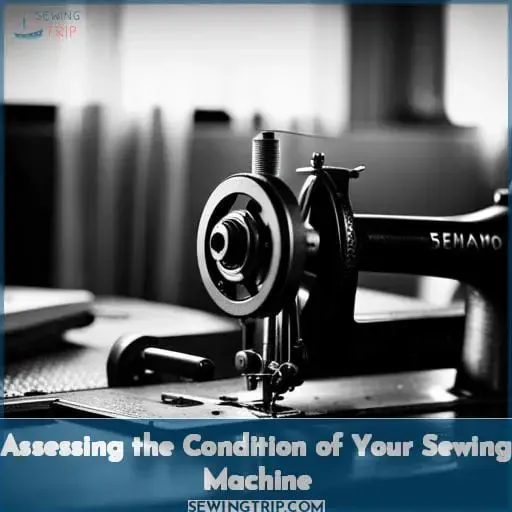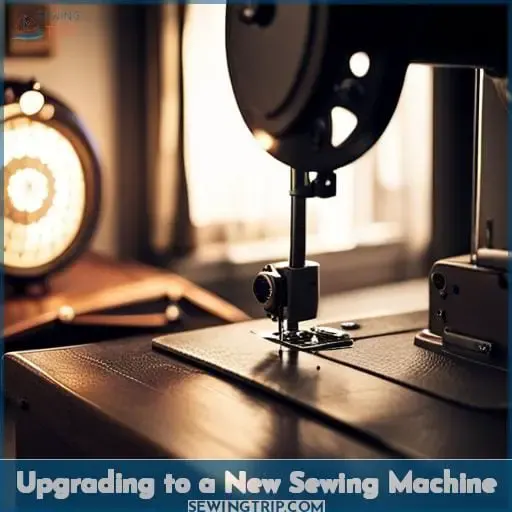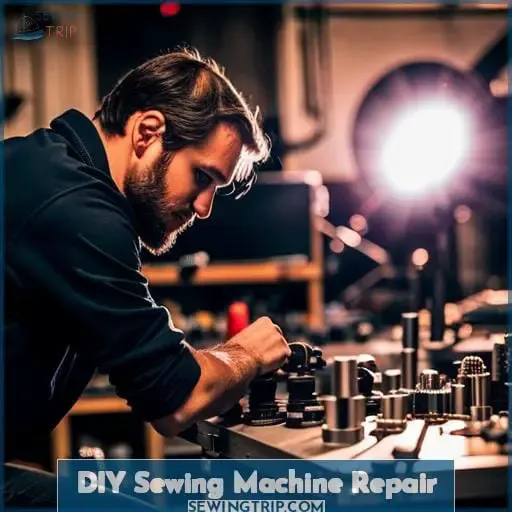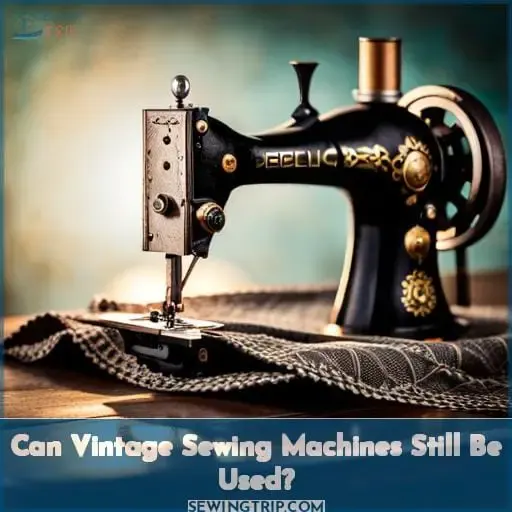This site is supported by our readers. We may earn a commission, at no cost to you, if you purchase through links.
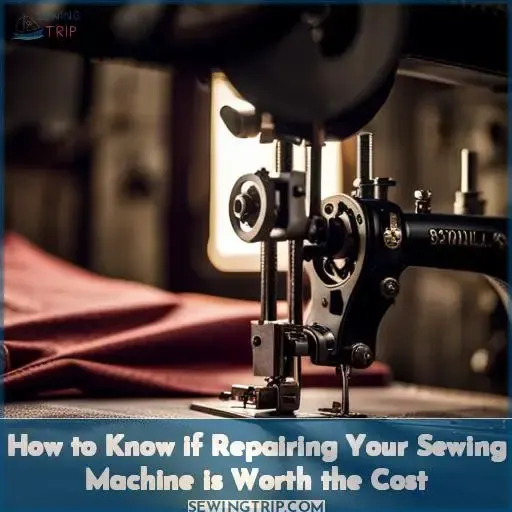 Having a broken sewing machine can be very stressful. It’s hard to know what the best solution is; should you spend money on repairs, or just buy a brand new one? The decision isn’t always easy, so it’s important to weigh your options carefully before making any decisions.
Having a broken sewing machine can be very stressful. It’s hard to know what the best solution is; should you spend money on repairs, or just buy a brand new one? The decision isn’t always easy, so it’s important to weigh your options carefully before making any decisions.
In this article, we’ll discuss how to determine if repairing your current sewing machine is worth the cost and whether upgrading might be more beneficial in the long run. We’ll also look at DIY repair options as well as vintage machines that are still usable today.
So let’s get started – by understanding all of your available options, you’ll soon have an answer about which route will make sense for you!
Table Of Contents
Key Takeaways
- Repair costs vary based on the problem and complexity.
- Comparing repair costs to the price of a new machine is helpful.
- Unusual sounds may indicate deeper issues.
- Assess the machine’s condition before deciding to repair or replace.
Is Repairing Worth the Cost?
Considering the time and money required to repair a sewing machine, it may be wiser to invest in a new one with desired features. Repairing costs vary widely depending on the type of problem and complexity involved.
Vintage machines are often difficult or impossible for technicians to fix due to missing parts or software issues. If you can find machine manuals online, troubleshooting tips may help identify problems quickly and save some repair costs.
Listen carefully for any unusual sounds coming from your machine; this could indicate deeper issues that require more expertise than just basic maintenance such as oiling and cleaning the throat plate or replacing needles/threads with little TLC!
However, don’t forget about warranty disclosure policies when repairing older models since they might not be covered by manufacturers anymore – so make sure you read up before making repairs!
Ultimately though, if stitch quality is important to you then investing in a newer model might give better results over an old one no matter how much love it needs – so weigh up all options carefully before deciding what’s best for your project goals!
Considering the Price of a New Sewing Machine
Comparing the cost of repairing your sewing machine to the price of a new one can help you decide which option is best for you. Consider repair costs, if upgrading will provide access to new features, and what’s available in your price range before making a decision.
Repair technicians may be able to fix some issues but won’t be able to work with missing gears or software problems, so consider an upgrade instead.
When shopping around for a used sewing machine online, always make sure you know what condition it’s in — especially when buying sight unseen! If possible, try out an amazing vintage find firsthand before purchasing by asking questions about its history and running a damp rag over all metal parts (free downloads are also available).
Once purchased, keep up regular maintenance: follow instructions closely, use quality supplies like Liberty Sewing Machine Oil, and clean regularly using Dritz Angled Lint Brush Blue, etc.
Assessing the Condition of Your Sewing Machine
Assess the condition of your sewing machine carefully before deciding whether to repair it or purchase a new one. Research pricing, manuals, and other resources online to evaluate options for repairing or replacing your machine.
Testing the machine in person is highly recommended if possible; otherwise, look for neutral places that are willing to do a demonstration prior to purchasing from thrift stores or online listings.
Cleaning tips may be found in downloadable manuals, such as those available free-of-charge on Pfaff’s website, for vintage Brother machines with metal plates like yours! If you don’t have luck finding this type of information there, try contacting customer service directly—they can often provide advice specific to your model and brand name.
Lastly, take caution when buying an old sewing machine unseen – make sure it comes with all necessary parts so you won’t end up spending more money later! With knowledge and patience, you can find yourself an excellent working unit at a great price – just keep an eye out for hidden gems along the way!
Upgrading to a New Sewing Machine
Upgrading to a new sewing machine can provide many benefits, from modern features and improved stitch quality to reduced repair costs. Sewing machines range in price significantly, so it’s important to consider the cost of repairs compared with the value of buying a new one.
However, vintage machines are often worth repairing due to their solid construction and metal parts—they even have unbeatable stitch quality! With proper cleaning and oiling techniques, plus replacing key components like needles or thread, you can get your old machine purring again in no time at all.
Modern machines come equipped with up-to-date technology, including variable speed settings for precise control over stitches per minute, as well as adjustable feed dogs which allow for greater accuracy when feeding fabric through your machine.
Finally, don’t forget about those unique specialty items like built-in embroidery hoops that help add creativity into your projects:
- Improved Stitch Quality
- Reduced Repair Costs
- Modern Features
- Unique Specialty Items
Regardless of whether you choose an upgrade or stick with what’s already there, investing some money into maintaining (or restoring) an older model is always worthwhile because it will keep running smoothly for years after purchase if properly cared for! Ultimately though, know what makes sense financially before making any decisions; doing research on pricing will give insight into how much ‘bang’ is really ‘worth’ its buck when considering modern vs vintage sewing needs & wants alike!
DIY Sewing Machine Repair
With DIY sewing machine repair, you can save time and money while still ensuring quality results. Even if you don’t have much experience in this area, there are plenty of helpful resources available to make the process easier than ever before.
Make sure to read up on troubleshooting tips so that when something goes wrong with your machine, you know what steps need to be taken next.
Additionally, research manual sources online or check out a local library for buying advice.
After getting a good feel for how a machine works and looks like, try taking some troubleshooting steps at home. Set up timing correctly by using instructions from the manufacturer’s website or watch tutorials on YouTube explaining how different parts work together harmoniously during functioning mode.
This will help prevent major breakdowns down the road as well as keep the warranty valid in case professional assistance is needed later on.
Can Vintage Sewing Machines Still Be Used?
Discovering the hidden gems of vintage sewing machines and learning how to use them can be a rewarding experience. Repairing parts, selecting needles, machine cleaning, oil maintenance – all are important steps in keeping these relics running as they should.
Although repairing costs may seem high at first glance, it’s often worth investing in mom’s old yellow Brother or purple Kenmore! With proper stitch length setting and tension adjustments, you’ll get professional results from your vintage sewing machine that will last for years to come.
It’s not just about nostalgia either; many find these machines handle thicker fabrics with ease and create unbeatable quality stitches compared to their modern counterparts.
Next time you’re browsing second-hand shops, don’t pass up on those beautiful pieces of history that could become part of your sewing journey!
Frequently Asked Questions (FAQs)
How do I know if I need to replace or repair my sewing machine?
Consider the cost of repairs, the price of a new machine, and the features you desire. Ask for a demonstration to test before buying and practice on scraps after oiling. Look online for manuals if needed. Follow troubleshooting steps if the machine is not working properly and consult a repair person when necessary.
What kind of maintenance do I need to do on my sewing machine?
Regular maintenance is key to keeping your sewing machine in top condition. Oil and clean parts regularly, replace the needle often, and always test on a scrap fabric before use – you’ll thank yourself later! Plus, many repairs can be done at home with minimal effort or cost.
What are the best features to look for when upgrading to a new sewing machine?
Look for features like a larger embroidery hoop, quality construction, and metal parts when upgrading to a new sewing machine. Ensure you have control, understanding, and liberation with the best stitch quality possible.
Investigate options that offer flexibility in fabric thicknesses while providing accuracy in oiling techniques.
What are the most common problems with sewing machines?
Common sewing machine problems include jammed threads, skipped stitches, and tension issues. Poor timing can cause fabric to bunch or jam the feed dogs. Electrical faults can lead to power surges or no power at all.
Malfunctioning parts like belts and gears may need replacing for smooth operation again.
Is it possible to purchase parts for vintage sewing machines?
Yes, it is possible to purchase parts for vintage sewing machines. You can find them online or in specialty stores. Be sure to double-check compatibility with your model before purchasing, as some parts are not interchangeable between different brands and models.
Conclusion
In conclusion, whether you choose to repair or upgrade your sewing machine, or opt to purchase a new one, it’s important to consider the cost of repairs compared to the price of a new machine. Consider the features desired in a new machine and the condition of the current machine.
Taking the time to assess the situation will help you make the best decision for you and your sewing needs. No matter what you decide, you can be sure that with a little bit of effort and the right tools, you can enjoy the satisfaction of a job well done.
The feeling of accomplishment when you fix a problem or create something beautiful is a reward all its own.

